- Clone
- Tau 12 (See other available formats)
- Regulatory Status
- RUO
- Other Names
- PHF-tau, paired helical filament-tau, neurofibrillary tangle protein, microtubule-associated protein tau, isoform 4, G protein beta1/gamma2 subunit-interacting factor 1, DDPAC, FTDP-17, MAPTL, MSTD, MTBT1, MTBT2, PPND
- Isotype
- Mouse IgG1
- Ave. Rating
- Submit a Review
- Product Citations
- publications
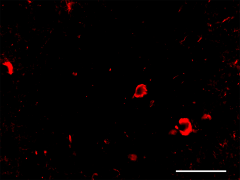
-

IHC staining Biotin anti-Tau, 6-18 antibody (clone Tau 12) on formalin-fixed paraffin-embedded Alzheimer’s disease brain tissue. Following antigen retrieval using Sodium Citrate H.I.E.R., the tissue was incubated with 1.0 µg/mL of the primary antibody overnight at 4°C, followed by incubation with Alexa Fluor® 594 streptavidin (Cat. No. 405240) for one hour at room temperature. Nuclei were counterstained with DAPI. The image was captured with a 60X objective. Scale bar: 50 µm -

IHC staining Biotin anti-Tau, 6-18 antibody (clone Tau 12) on formalin-fixed paraffin-embedded Alzheimer’s disease brain tissue. Following antigen retrieval using Sodium Citrate H.I.E.R., the tissue was incubated with 1.0 µg/mL of the primary antibody overnight at 4°C, followed by incubation with Alexa Fluor® 594 streptavidin (Cat. No. 405240) for one hour at room temperature. Nuclei were counterstained with DAPI. The image was captured with a 60X objective. Scale bar: 50 µm -

IHC staining of Biotin anti-Tau, 6-18 (clone Tau 12) on formalin-fixed paraffin-embedded human Alzheimer’s brain tissue. Following antigen retrieval using Sodium Citrate H.I.E.R. (Cat. No. 928502), the tissue was incubated with primary antibody overnight at 4°C. BioLegend’s Ultra Streptavidin HRP Kit (Multi-Species, DAB, Cat. No. 929501) was used for detection followed by hematoxylin counterstaining. Images were captured with a 40X objective and merged. Scale bar: 50 µm
| Cat # | Size | Price | Quantity Check Availability | Save | ||
|---|---|---|---|---|---|---|
| 806505 | 25 µg | 109€ | ||||
| 806506 | 100 µg | 348€ | ||||
Tau protein promotes microtubule assembly and stability. Tau is abundant in neurons of the central nervous system, and is expressed at low levels in astrocytes and oligodendrocytes. Abnormal hyper-phosphorylation, aggregation, and toxic gain of function of tau is associated with several neurological disorders, including Alzheimer’s disease (AD). The major building block of neurofibrillary lesions in AD brains consists of paired helical filaments (PHFs) of abnormally hyperphosphorylated tau. Six isoforms of tau are generated by alternative splicing of the MAPT gene. These isoforms are distinguished by the number of tubulin binding domains, 3 (3R) or 4 (4R), in the C-terminal of the protein and by one (1N), two (2N), or no (0N) inserts in the N-terminal domain. Tau isoforms are differentially expressed during development.
Product DetailsProduct Details
- Verified Reactivity
- Human
- Antibody Type
- Monoclonal
- Host Species
- Mouse
- Formulation
- Phosphate-buffered solution, pH 7.2, containing 0.09% sodium azide
- Preparation
- The antibody was purified by affinity chromatography and conjugated with biotin under optimal conditions.
- Concentration
- 0.5 mg/mL
- Storage & Handling
- The antibody solution should be stored undiluted between 2°C and 8°C. Do not freeze.
- Application
-
IHC-P - Quality tested
- Recommended Usage
-
Each lot of this antibody is quality control tested by formalin-fixed paraffin-embedded immunohistochemical staining. For immunohistochemistry, a concentration range of 0.1 - 1.0 µg/mL is suggested. It is recommended that the reagent be titrated for optimal performance for each application.
- Application Notes
-
This antibody is specific for an epitope that lies between amino acids 6-18 of human Tau.
- Application References
-
- Irwin D, et al. 2012. Brain. 135(Pt 3):: 807. (IHC-P) PubMed
- Horowitz PM, et al. 2004. J Neurosci. 24(36):7895 (WB)
- Sengupta U, et al. 2017. Ann Clin Transl Neurol. 4(4):226. (WB) PubMed
- Meredith JE, et al. 2013. PLoS One. 7;8(10):e76523 (ELISA, WB) PubMed
- Song L, et al. 2015, Mol Neurodegener. 10:14 (ELISA, WB) PubMed
- RRID
-
AB_2861079 (BioLegend Cat. No. 806505)
AB_2861079 (BioLegend Cat. No. 806506)
Antigen Details
- Structure
- Unmodified Tau isoforms have an apparent molecular weight ranging from 33-79 kD. Additional high and low molecular weight Tau species have been observed in brain tissues.
- Distribution
-
Tissue distribution: Central nervous system, peripheral ganglia and nerves, kidney, skeletal, and heart muscle.
Cellular distribution: Cytoskeleton, nucleus, plasma membrane, and cytosol. - Function
- Tau promotes microtubule assembly and stability. The short tau isoforms allow plasticity of the cytoskeleton whereas the longer isoforms may preferentially play a role in its stabilization.
- Interaction
- Tau interacts with: Sequestosome-1, Peptidyl-prolyl cis-trans isomerase FKBP4, Casein kinase I isoform delta, Serine/threonine-protein kinase Sgk1, Laforin, and alpha-synuclein.
- Biology Area
- Cell Biology, Neurodegeneration, Neuroscience, Protein Misfolding and Aggregation
- Molecular Family
- Tau
- Antigen References
-
1. Meredith JE Jr, et al. 2013. PLoS One. 8(10): e76523. PubMed
2. Goodall CA, et al. 2006. J. Neurol. Neurosurg. Psychiatry 77(1): 89. PubMed
3. Wang Y, Mandelkow E. 2016. Nat. Rev. Neurosci. 17(1):5-21. PubMed - Gene ID
- 4137 View all products for this Gene ID
- UniProt
- View information about Tau 6-18 on UniProt.org
Related Pages & Pathways
Pages
Related FAQs
- How many biotin molecules are per antibody structure?
- We don't routinely measure the number of biotins with our antibody products but the number of biotin molecules range from 3-6 molecules per antibody.
Other Formats
View All Tau, 6-18 Reagents Request Custom Conjugation| Description | Clone | Applications |
|---|---|---|
| Purified anti-Tau, 6-18 | Tau 12 | WB,IHC,ELISA |
| Biotin anti-Tau, 6-18 | Tau 12 | IHC-P |
Customers Also Purchased
Compare Data Across All Formats
This data display is provided for general comparisons between formats.
Your actual data may vary due to variations in samples, target cells, instruments and their settings, staining conditions, and other factors.
If you need assistance with selecting the best format contact our expert technical support team.
-
Purified anti-Tau, 6-18
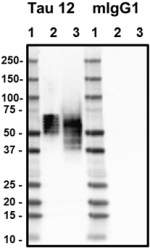
Western blot of anti-Tau, 6-18 antibody (clone Tau 12). Lane... 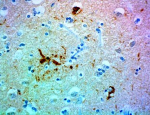
IHC staining of anti-Tau, 6-18 antibody (clone Tau 12) on fo... 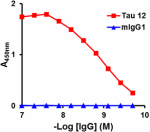
Direct ELISA of anti-Tau, 6-18 Antibody (clone Tau 12) and i... -
Biotin anti-Tau, 6-18
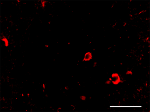
IHC staining Biotin anti-Tau, 6-18 antibody (clone Tau 12) o... 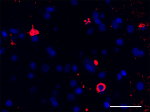
IHC staining Biotin anti-Tau, 6-18 antibody (clone Tau 12) o... 
IHC staining of Biotin anti-Tau, 6-18 (clone Tau 12) on form...

 Login / Register
Login / Register 







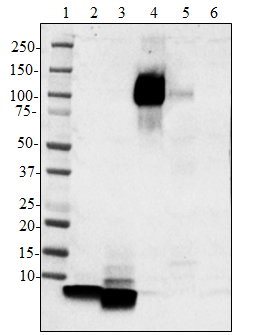
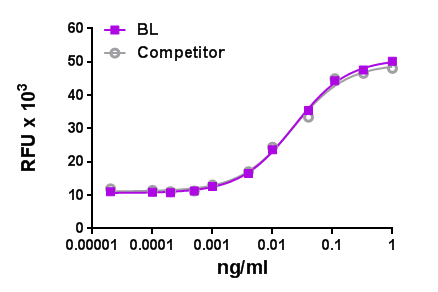
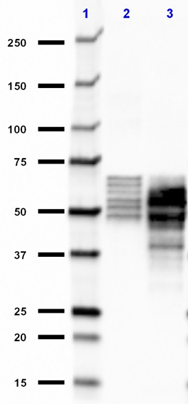



Follow Us